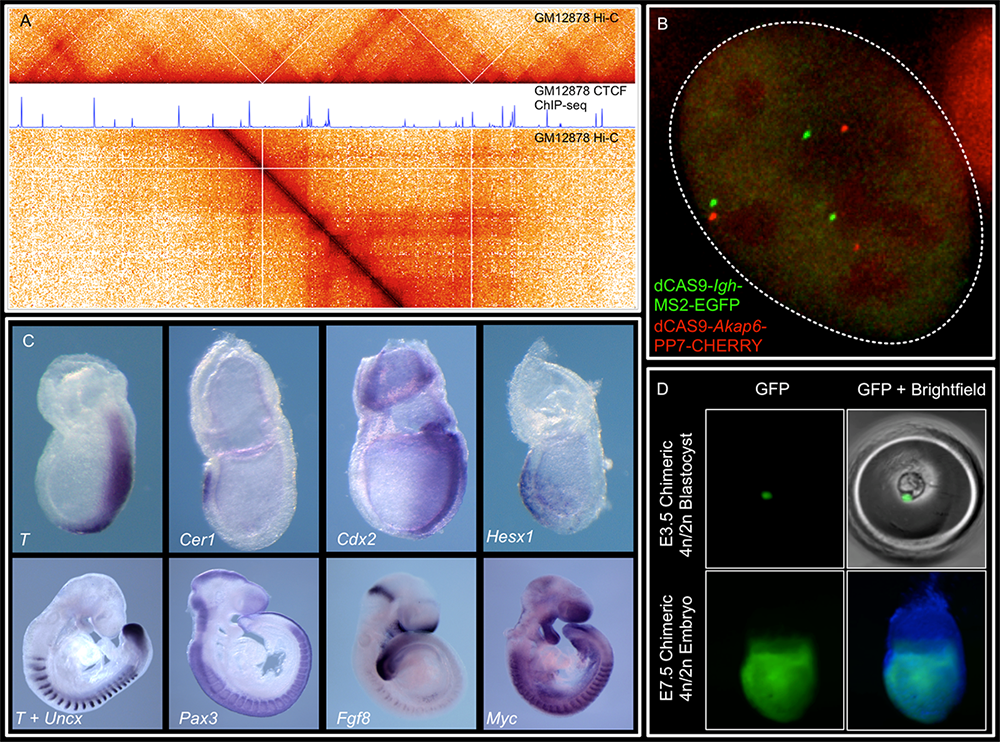Three-Dimensional Organization of the Genome as a Determinant of Cell-Fate Decisions

- Pedro Rocha, PhD, Head, Unit on Genome Structure and Regulation
- Nina Kopitchinski, Lab Manager
- Shreeta Chakraborty, PhD, Postdoctoral Fellow
- Joyce J. Thompson, PhD, Postdoctoral Fellow
- Zhenyu Zuo, PhD, Postdoctoral Fellow
Our lab seeks to understand cell-lineage differentiation, gene regulation, and how non-coding DNA elements and the 3D architecture of chromosomes contribute to such processes during development and disease. We are also interested in early mammalian development as a system in which to decipher how cells make lineage decisions and how gene-regulatory networks are established.
Figure 1. Representative image of the lab's research
We combine imaging techniques in both fixed and living cells with sequencing-based genomic techniques that assess DNA–DNA interactions.
A. Hi-C and CTCF ChIP-Seq of GM1278 cells, which allow characterization of chromatin structure and identification of binding sites of an important architectural protein.
B. dCAS9 MCP-EGFP and PCP-CHERRY live imaging of the Igh and Akap6 loci. The mouse embryo is an unparalleled system in mammalian biology for understanding how tissue-specific gene expression is achieved.
C. Whole-mount in situ hybridization for patterning markers in mid and late gastrulating embryos.
D. Tetraploid aggregation with GFP (green fluorescent protein)–labeled ES (embryonic stem) cells allows generation of fully ES cell–derived embryos.
Eukaryotic cells need to deal with the biophysical constraints of packaging two meters of DNA inside a tiny nucleus (2–10 microns) and still retain the ability to access both its coding and non-coding elements to precisely orchestrate gene expression programs. Research over the past decade has begun to elucidate the mechanisms through which DNA condensation and organization in the nucleus are achieved. The results of such research suggest that the processes are tightly controlled and are themselves critical components of gene regulation. Our long-term goal is to understand how such processes occur in vivo and how their regulation dictates cell identity and cell-fate decisions in mammals.
To do so, we combine the robustness of mouse-genome editing and genetics with cutting-edge sequencing-based genomic techniques such as ATAC-Seq (assay for transposase-accessible chromatin using sequencing), ChIP-Seq (chromatin-immuno-precipitation DNA-sequencing), and Hi-C (high-throughput chromosome conformation capture technique), as well as live-imaging approaches. We believe that the early mouse embryo is an ideal model system in which to determine how nuclear architecture is regulated in the context of an organism and how that impacts cell behavior and identity.
Fertilization is the ultimate reprogramming experiment, where two highly differentiated cells (oocyte and sperm) fuse to form a zygote with totipotent potential. This involves a massive rearrangement of epigenetic modifications, both at the level of the DNA and of the histones, and the activity of many transcriptional regulators. Our studies aim to understand how 3D chromatin structures are established during this period and how they impact future developmental decisions.
Following fertilization and within a few cell divisions, the first cell lineages are established and different gene-expression programs are put into action. In mammals, the result is the formation of the blastocyst, a structure that contains three different cell types, each with a defined differentiation potential. The trophectoderm is responsible for forming the placenta, the primitive endoderm leads to the yolk sac, and the epiblast gives rise to all remaining embryonic tissues. We will build on decades of lineage-fate experiments and precisely characterized signaling pathways known to regulate early mouse development to understand the contribution of nuclear organization to gene regulation during these early cell fate decisions.
We are also interested in understanding not only how DNA organization impacts cell behavior, and ultimately animal development and health, but also the mechanisms through which DNA folding itself is established and regulated, and which proteins are involved in these processes. To broadly address such questions, we will employ several high-throughput technologies that we have established in the lab, in combination with genome-wide CRISPR screens. Ultimately, we will fully characterize in vivo candidates identified this way to stringently determine their impact on gene regulation during mammalian development.
Publications
- Chakraborty S, Kopitchinski N, Zuo Z, Eraso A, Awasthi P, Chari R, Mitra A, Tobias IC, Moorthy SD, Dale RK, Mitchell JA, Petros TJ, Rocha PP. Enhancer-promoter interactions can bypass CTCF-mediated boundaries and contribute to phenotypic robustness. Nat Genet 2022 1–12.
- Thompson JJ, Lee DJ, Mitra A, Frail S, Dale RK, Rocha PP. Extensive co-binding and rapid redistribution of NANOG and GATA6 during emergence of divergent lineages. Nat Commun 2022 13:4257.
- Kurotaki D, Kikuchi K, Cui K, Kawase W, Saeki K, Fukumoto J, Nishiyama A, Nagamune K, Zhao K, Ozato K, Rocha PP, Tamura T. Chromatin structure undergoes global and local reorganization during murine dendritic cell development and activation. Proc Natl Acad Sci U S A 2022 119:e2207009119.
- Beck DB, Basar MA, Asmar AJ, Thompson JJ, Oda H, Uehara DT, Saida K, Pajusalu S, Talvik I, D'Souza P, Bodurtha J, Mu W, Baranano KW, Miyake N, Wang R, Kempers M, Tamada T, Nishimura Y, Okada S, Kosho T, Dale R, Mitra A, Macnamara E, Matsumoto N, Inazawa J, Walkiewicz M, Ounap K, Tifft CJ, Aksentijevich I, Kastner DL, Rocha PP, Werner A. Linkage-specific deubiquitylation by OTUD5 defines an embryonic pathway intolerant to genomic variation. Sci Adv 2021 7(4):eabe2116.
- Rhodes C, Mitra A, Lee D, Lee D, Zhang Y, Thompson J, Rocha P, Dale R, Petros T. Single cell chromatin accessibility reveals regulatory elements and developmental trajectories in the embryonic forebrain. Nat Commun 2022 13:4196.
Collaborators
- Bradley Bernstein, MD, PhD, Broad Institute and Dana-Farber Cancer Institute, Cambridge, MA
- Stefan Feske, MD, New York University School of Medicine, New York, NY
- Daniel Herranz, PharmD, PhD, Cancer Institute of New Jersey, Rutgers University, New Brunswick, NJ
- Mark Lewandoski, PhD, Cancer and Developmental Biology Laboratory, Center for Cancer Research, NCI, Frederick, MD
- Timothy Petros, PhD, Unit on Cellular and Molecular Neurodevelopment, NICHD, Bethesda, MD
- Achim Werner, PhD, Stem Cell Biochemistry Unit, NIDCR, Bethesda, MD
Contact
For more information, email pedro.rocha@nih.gov or visit https://rochalab.nichd.nih.gov.



